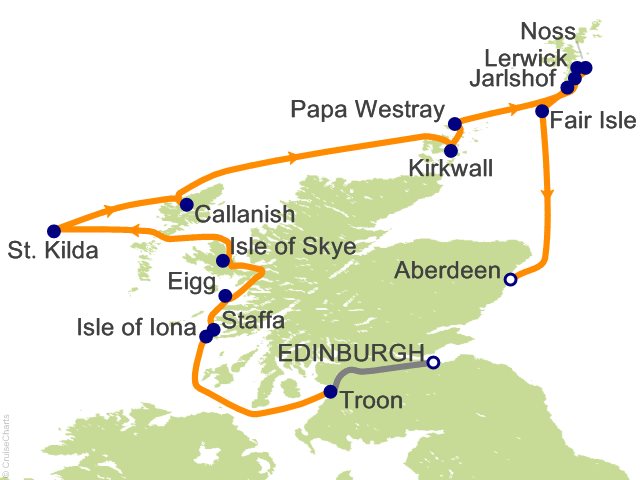At the Knap of Howar on Papa Westray lies the earliest known house in Northern Europe, occupied by Neolithic farmers over 5,000 years ago. Here we are welcomed by the friendly locals. Enjoy the lively Scottish dance and folk ensemble, "Poor Man's Corner", hailing from Papa Westray, set to grace the local pub with their spirited tunes. Mingle and enjoy a few drinks, while listening to the captivating melodies and infectious rhythms. Britain's most northerly islands lie almost 160 kilometers (99 miles) north of the Scottish mainland, at a similar latitude to the southern tip of Greenland, or Bergen in Norway. Kept relatively warm by the Gulf Stream, Shetland's 100 islands experience almost 24 hours of daylight in summer. They abound with nature reserves and archaeological sites and offer a taste of traditional island life. We plan to explore some of the following sites: In Lerwick, learn stories of smugglers, fisherman, Vikings, and fictional detectives as you walk around Shetland's bustling capital. Lerwick may mean 'muddy bay' in Old Norse but there's nothing damp or gloomy about this thriving seaport. Take a guided walking tour of the town and learn all about its history and most iconic buildings. With its mile-long seabird cliffs, the Island of Noss is a National Nature Reserve. In breeding season the sound of around 150,000 birds and chicks fills the air. Millions of years of wind and ice have honeycombed thousands of nesting ledges in sandstone cliffs almost 200 meters / 656 feet high. Resident seals and visiting otters feed in dense kelp around the shores. Jarlshof is one of Shetland's best preserved and most complex archaeological sites. It was exposed by storms in the late 19th century. The Old House of Sumburgh, built here in the 17th century, was named 'Jarlshof' by Sir Walter Scott in his novel 'The Pirate'. The record of human occupation dates from around 3200 BCE. Jarlshof's main Bronze Age site is the house of a bronzesmith working around 800 BC. Clay molds into which molten bronze was poured revealed that he was casting axe heads and short swords. It seems that Shetland suited early Norse settlers, for they quickly settled here and left their mark on Shetland's history for ages to come. Mousa Broch, on the small uninhabited island of Mousa, is the best-preserved of Scotland's 570 brochs (fortified Iron Age towers). Storm petrels nest among its stones, which can be seen when visiting the broch at night. In daylight, a large colony of common and grey seals basks on its shores, and you may spot otter (dratsi, in Shetland dialect). ...
Read More




































 Track this Cruise.
Track this Cruise.  Favorite this Cruise and receive Price Alerts when the rates go up or down.
Favorite this Cruise and receive Price Alerts when the rates go up or down.
















